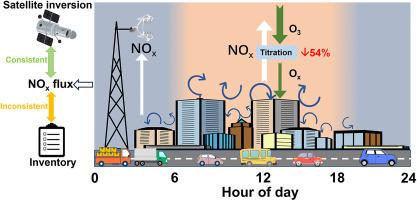NOx, O3和Ox的通量测量:排放特性,库存验证和滴定效应
IF 7.3
2区 环境科学与生态学
Q1 ENVIRONMENTAL SCIENCES
引用次数: 0
摘要
作为臭氧和二次粒子的前体,对NOx排放动力学的不完全了解限制了我们充分阐明空气污染形成的能力。通量测量为氮氧化物排放和滴定效应提供了新的见解。本文介绍了2023年夏季北京市区NOx、O3和Ox的涡动相关通量测量结果。实测NOx通量为正,24 h平均值为10.8±10.7 nmol/m2/s,处于城市报告通量的低端。北京市区NOx排放强度较低可能与柴油车控制措施的成功有关,同时也证实了NOx通量与交通流量的显著依赖性。测量到的氮氧化物通量与排放清单估计值之间存在1.3-14.5倍的差异,这表明大多数排放清单可能无法准确表征北京的氮氧化物排放。通量测量与卫星反演之间取得了较好的一致性。与NOx相反,臭氧(O3)和Ox (= O3 + NO2)的通量主要向下。采用多元线性回归(MLR)方法研究了NOx排放对臭氧下行通量的影响,结果表明,NOx排放对臭氧下行通量的影响占观测期内臭氧下行通量平均值的54±53%。该研究证明了通过对NOx、O3和Ox的涡流相关通量测量提供的有关排放强度和化学转化的有价值的信息。本文章由计算机程序翻译,如有差异,请以英文原文为准。

Flux Measurements of NOx, O3 and Ox: Emission Characteristics, Inventory Validation and Titration Effects
As the precursor of ozone and secondary particles, the incomplete knowledge of NOx emission dynamics constrains our ability to fully elucidate air pollution formation. Flux measurements offer new insights into NOx emissions and titration effects. Here, we present eddy covariance flux measurements of NOx, O3 and Ox in urban Beijing during the summer of 2023. The measured NOx flux was positive with the 24-h average of 10.8 ± 10.7 nmol/m2/s, which is at the lower end of the flux reported in urban regions. The low NOx emission strength in urban Beijing may be related to the successful control measures of diesel vehicles, while confirming significant dependence of NOx flux with traffic flow. The discrepancies by a factor of 1.3-14.5 between measured NOx flux and estimates in emission inventories are observed, indicating most emission inventories may fail to accurately characterize NOx emissions in Beijing. Better agreements between flux measurements and satellite retrieval are obtained. In contrast to NOx, predominantly downward fluxes were observed for ozone (O3) and Ox (= O3 + NO2). A multiple linear regression (MLR) method is developed to examine the impacts of NOx emissions on the ozone downward flux, revealing that NOx emissions induce 54 ± 53% of ozone downward flux average over the observation period. This study demonstrates valuable information on emission strength and chemical transformation provided by eddy covariance flux measurements of NOx, O3 and Ox.
求助全文
通过发布文献求助,成功后即可免费获取论文全文。
去求助
来源期刊

Environmental Pollution
环境科学-环境科学
CiteScore
16.00
自引率
6.70%
发文量
2082
审稿时长
2.9 months
期刊介绍:
Environmental Pollution is an international peer-reviewed journal that publishes high-quality research papers and review articles covering all aspects of environmental pollution and its impacts on ecosystems and human health.
Subject areas include, but are not limited to:
• Sources and occurrences of pollutants that are clearly defined and measured in environmental compartments, food and food-related items, and human bodies;
• Interlinks between contaminant exposure and biological, ecological, and human health effects, including those of climate change;
• Contaminants of emerging concerns (including but not limited to antibiotic resistant microorganisms or genes, microplastics/nanoplastics, electronic wastes, light, and noise) and/or their biological, ecological, or human health effects;
• Laboratory and field studies on the remediation/mitigation of environmental pollution via new techniques and with clear links to biological, ecological, or human health effects;
• Modeling of pollution processes, patterns, or trends that is of clear environmental and/or human health interest;
• New techniques that measure and examine environmental occurrences, transport, behavior, and effects of pollutants within the environment or the laboratory, provided that they can be clearly used to address problems within regional or global environmental compartments.
 求助内容:
求助内容: 应助结果提醒方式:
应助结果提醒方式:


